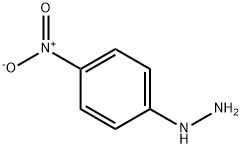4-Nitrophenylhydrazine
|
|
4-Nitrophenylhydrazine 속성
- 녹는점
- 156 °C (dec.)(lit.)
- 끓는 점
- 276.04°C (rough estimate)
- 밀도
- 1.00
- 굴절률
- 1.6910 (estimate)
- 저장 조건
- Explosives area
- 산도 계수 (pKa)
- 3.81±0.20(Predicted)
- 색상
- 주황색-빨간색 바늘 모양의 물질
- 수용성
- 뜨거운 물에 용해됨
- Merck
- 14,6624
- BRN
- 608107
- CAS 데이터베이스
- 100-16-3(CAS DataBase Reference)
안전
- 위험 및 안전 성명
- 위험 및 사전주의 사항 (GHS)
| 위험품 표기 | F,Xn | ||
|---|---|---|---|
| 위험 카페고리 넘버 | 5-11-22-36/37/38-43-21/22 | ||
| 안전지침서 | 16-26-36/37/39-37/39-36 | ||
| 유엔번호(UN No.) | UN 3376 4.1/PG 1 | ||
| WGK 독일 | 3 | ||
| RTECS 번호 | MV8225000 | ||
| F 고인화성물질 | 4.6 | ||
| 위험 참고 사항 | Flammable/Harmful | ||
| 위험 등급 | 4.1 | ||
| 포장분류 | I | ||
| HS 번호 | 29280000 | ||
| 독성 | mmo-sat 2 mmol/L AEMIDF 44,801,82 |
4-Nitrophenylhydrazine C화학적 특성, 용도, 생산
화학적 성질
white to light yellow crystal powde용도
4-Nitrophenylhydrazine is a nitro substituted aryl hydrazine with potential anticancer activity. Irritant.정의
ChEBI: A member of the class of phenylhydrazines that is phenylhydrazine substituted at the 4-position by a nitro group.일반 설명
4-Nitrophenylhydrazine is a orange-red leaflet or needles wetted with water. 4-Nitrophenylhydrazine will emit toxic oxides of nitrogen when heated to decomposition. 4-Nitrophenylhydrazine is slightly heavier than water and insoluble in water. 4-Nitrophenylhydrazine may be irritating to skin, eyes and mucous membranes. 4-Nitrophenylhydrazine may be toxic by ingestion. 4-Nitrophenylhydrazine may be explosive and sensitive to friction in the dry state. 4-Nitrophenylhydrazine is used as a reagent for ketones and aliphatic aldehydes.반응 프로필
4-NITROPHENYLHYDRAZINE is a powerful explosive. 4-Nitrophenylhydrazine can SELF-IGNITE in the presence of contaminants. Auto-ignition temperature may vary for 4-nitrophenylhydrazine similar to that of hydrazine which has an autoignition of as low as 74oC in contact with iron rust. Dangerous fire hazard or severe explosion can occur when exposed to heat, flame or oxidizing agents. Severe explosion may also occur by chemical reaction with alkali metals; BaO; CaO; K; Na; NH3; Cl2; chromates; CuO; Cu++ salts; F2; H2O2; iron rust; metallic oxides; PbO2;Ni; Ni(ClO4)2; HNO3; N2O; O2; liquid O2; K2Cr2O7; Na2Cr2O7; tetryl; zinc diamide; Zn(C2H5)2. Dangerous; when heated to decomposition 4-Nitrophenylhydrazine emits highly toxic nitrogen compounds; may explode by heat or chemical reaction. (Sax and Lewis, 1987) under Hydrazine p. 538-539.건강위험
Some are toxic and may be fatal if inhaled, swallowed or absorbed through skin. Contact may cause burns to skin and eyes. Fire may produce irritating, corrosive and/or toxic gases. Runoff from fire control or dilution water may cause pollution.Safety Profile
Poison by intraperitoneal route.Mutation data reported. When heated to decomposition itemits toxic fumes of NOx. See also NITROCOMPOUNDS OF AROMATIC HYDROCARBONSPurification Methods
Crystallise the hydrazine from EtOH. The hydrochloride has m 212o(dec) (from EtOH, also m 202-203o dec). [Beilstein 15 III 331, 15 IV 317.]4-Nitrophenylhydrazine 준비 용품 및 원자재
원자재
준비 용품
5-Aminoindole
1-METHYL-5-NITRO-1H-INDOLE
5-Nitroindole
4-THIOPHEN-2-YLPHENYLAMINE
Ethyl 5-nitroindole-2-carboxylate
5-amino-1H-Indole-2-carboxylic acid ethyl ester
ETHYL 5-AMINO-1H-INDOLE-2-CARBOXYLATE
2,3,5-Trimethylthiophene
니트로 BT
2-METHYL-5-NITROINDOLE
1-(4-NITROPHENYL)-3-METHYL-5-PYRAZOLONE
4-니트로비페닐
carbazol-3-ylamine
4-Nitrophenylhydrazine 관련 검색:
3-나이트로벤젠설폰산 나트륨 염 p-플루오로미트로벤젠 디플로로니트로벤젠(3,4-) 4-니트로안식향산 나이트로벤젠 M-디니트로벤젠 2,4-디나이트로페닐히드라진 2-피리딘카르복살디하이드 4-니트로페닐하이드라존 1,1-디페닐-2-피크릴하이드라이진 피크롤론산
p-Nitrophenylacetonitrile
4-Nitrophenyl chloroformate
4-Nitrobenzaldehyde
4-Nitrophenylacetic acid
4-NITROPHENYLACETYLENE
4-Nitrobenzonitrile
3-Nitrobenzaldehyde
4-Nitrobenzeneethanol








